Good branding can increase both brand awareness and loyalty without customers even realizing it. When people recognize a brand, they inherently trust that company more—which is why putting a major emphasis on your branding is key to success.
That also includes your social media marketing. While many people think of branding as a company’s logo, website, and print marketing materials, their social media strategy and online presence are just as important.
Throughout this article, we’re going to talk more about what social media branding is, why it’s important, plus 12 essential social media branding tips for creating a cohesive brand online.
Table of Contents
What is social media branding?
12 strategies to create consistent social media branding
1. Have a uniform brand identity across all social media channels
2. Understand your target audience
3. Establish the tone of voice for your brand on social media
4. Choose the right social media platforms for your brand
5. Create engaging, on-brand content
6. Develop social media employer branding programs
7. Involve your C-level suite in talking about your brand on social media
8. Position yourself as brand authority in your niche
9. Promote your brand impact on social media
10. Identify and engage with influencers or other brand partnerships
11. Team up with your customer service to have a unified customer experience on social media
12. Analyze your brand performance on social media
What is social media branding?
Social media branding is the process of building a strong brand through the use of social media. This includes showcasing your brand visuals while also ensuring your brand’s mission comes across.
The main components of social media branding include:
- Visual branding: Ensuring your visuals, like your logo and colors, are prominent across all of your social media profiles.
- Brand voice: Using a voice and personality in your social media content that matches your voice on your website, sales collateral, and anything else your business puts out.
- Positioning: Your positioning or marketing messaging is also a big part of your brand, both online and offline. This should remain consistent across the board.
- Brand mission: Finally, make sure your brand’s mission, also known as your vision or purpose, is incorporated into your social media branding.
Branding on social media should be a major part of your overall branding strategy, ensuring all of your marketing, visuals, and more are aligned across all channels.
Why is it important to have a consistent brand identity on social media?
When it comes to branding, consistency is key. In fact, one study found that brand consistency increases revenue by 10-20%. And this translates to your social media branding efforts as well.
By keeping your social media branding aligned with your traditional branding, you immediately make your social media platforms recognizable and trustworthy.
People who already know your brand will be more likely to follow you. And people who are being introduced to your brand on social media will be more likely to buy from you when they see that your website and other branding also match.
That’s just the tip of the iceberg, too. Brand consistency is an essential part of running your business. So, let’s talk about how to ensure your social media branding plan goes off without a hitch.

12 strategies to create consistent social media branding
#1. Have a uniform brand identity across all social media channels
Step one to cohesion is ensuring consistent branding across your social media channels. This includes things like:
- Your profile photo
- Your cover photo
- Your username/handle
- Your bio
Let’s look at an example. Take a look at vitamin company Ritual’s Facebook page below:

We see a solid yellow profile photo and a branded cover photo to boot. The brand’s Facebook URL is facebook.com/ritual.
Now let’s look at Instagram:
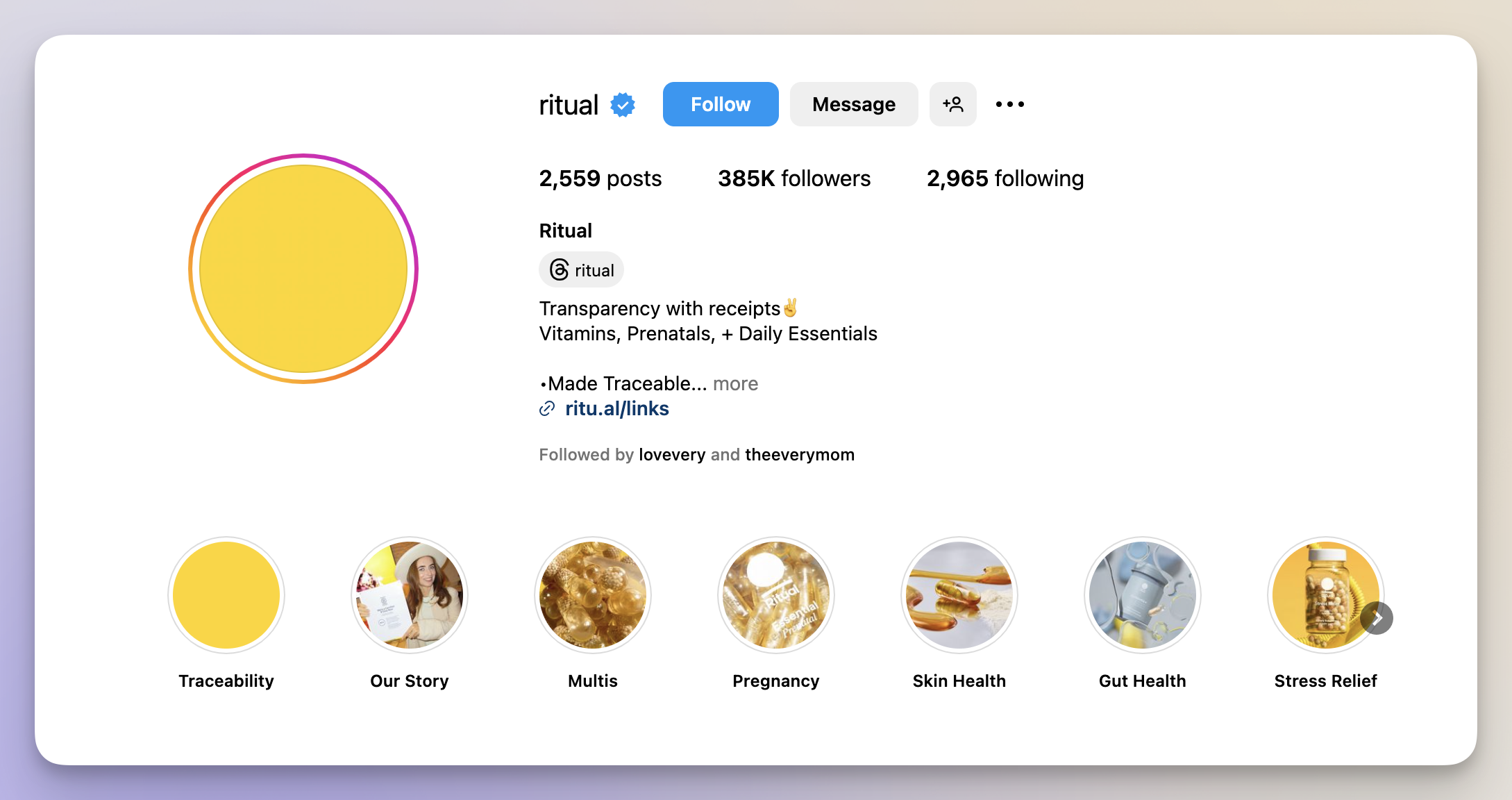
Not only do we have the same solid yellow profile photo matching Ritual’s brand color, we also can see that yellow pulled into its Instagram story highlight covers. And its Instagram handle is @ritual, perfectly matching its Facebook URL to make it as easy to find their online presence as possible.
While you’re restricted to a social media platform’s overall design, there are still areas in which you can—and should—inject your brand. Pay attention to the correct image sizes for each platform so that your graphics are high-quality and represent your brand well.
Branding your social media presence is key before you get started with any of these other tactics for branding through social media marketing. It sets the tone for the rest of your digital branding strategy.
#2. Understand your target audience
Your target audience should be a major consideration as you put together your brand identity. After all, their opinion of it—and whether it matches their tastes—will have a big impact on whether they want to follow you on social media and purchase your products.
If you haven’t already, put together a customer persona to outline who exactly your target customer is. This is great for putting together an audience profile to guide your overall marketing messaging, but can also be helpful for creating and promoting a brand identity that will resonate.
Your persona should include basic information, like demographics and purchasing patterns, but you can also include details like:
- Interests
- Favorite social media platforms
- Aesthetic(s)
- Favorite content type
- Personality traits
Find this information via market research, customer interviews, survey data, and the details you might already know about your target audience.
#3. Establish the tone of voice for your brand on social media
Your brand voice is another important part of your overall brand identity. This is the tone and personality you use in your messaging—your captions and other written content across your online presence.
Establishing your brand voice makes it easier to create consistent content and also helps your business resonate better with customers.
Let’s look at a couple of brand voice examples so you can see what we mean.
For example, there's Duolingo—the language learning app with an absolutely chaotic online presence. Duolingo’s mascot, Duo the Owl, makes an appearance in a good bit of the brand’s online photos and videos—but regardless, the captions are always humorous and engaging.
And there's always Wendy’s—a fast food restaurant that also leans towards a more humorous presence while still remaining relevant to its core offerings. Here’s an example of the brand roasting McDonald’s for their limited “free fries” offer.
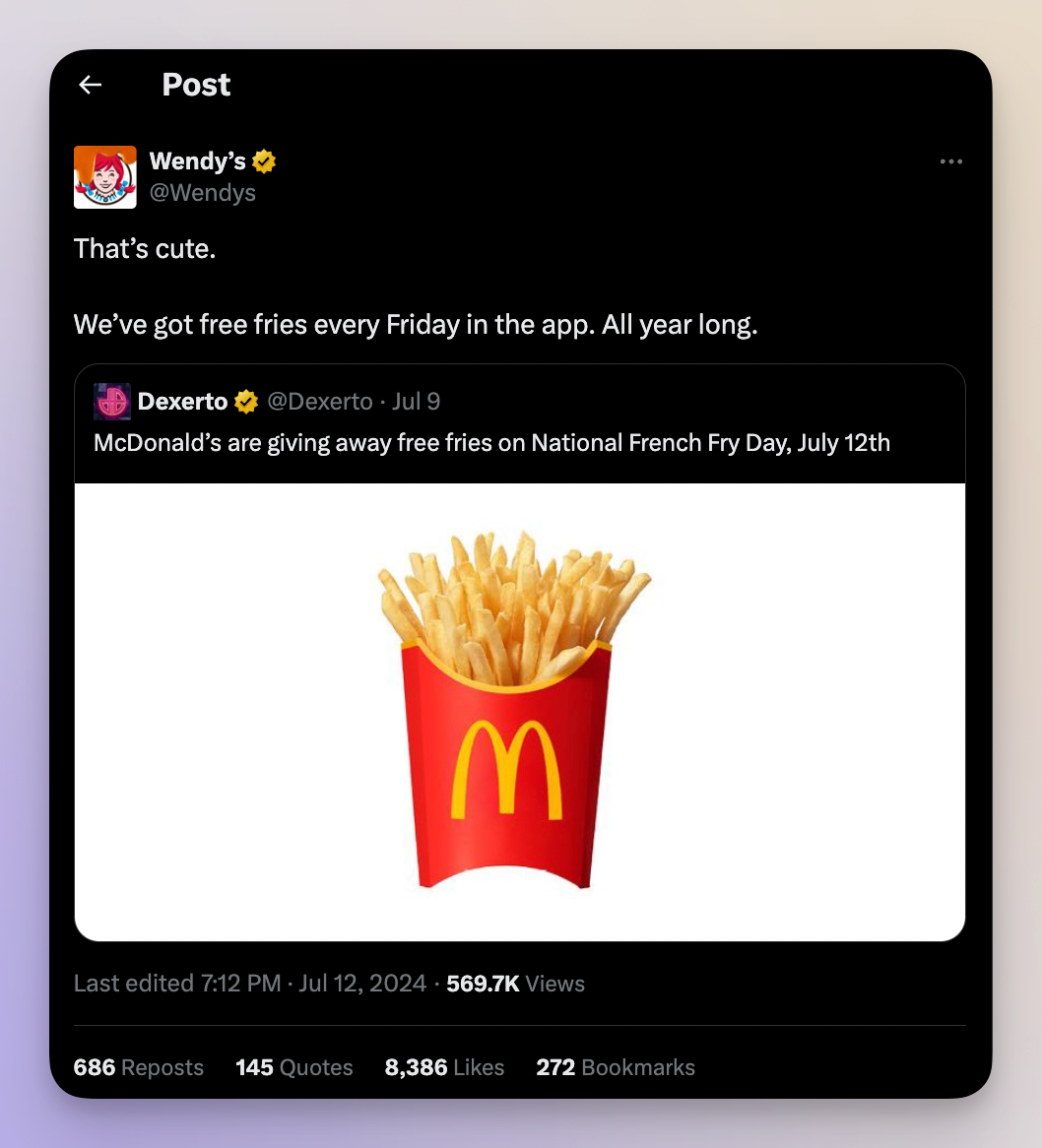
Decide how you want to sound online in a way that makes sense for your brand.
Put together a few adjectives that define the tone of voice you’re going for, alongside some examples you’ve found online to help structure your copy going forward.
#4. Choose the right social media platforms for your brand
You don’t have to have a presence on every single social media platform. That sounds exhausting—and absolutely impossible for a small team. Instead, you need to choose the right social media platforms for your brand.
Visual brands should consider platforms like Instagram, TikTok, and Pinterest. Brands with a fun voice or personality, like some of the ones we covered in the last point, might lean towards platforms like X/Twitter or TikTok.
Brands that want to use their social media platforms as an educational tool might choose to focus on platforms like YouTube and LinkedIn. And brands targeting younger audiences might put their efforts in platforms like TikTok and Instagram.
Consider your target audience, the types of content you want to share, and your business industry before you decide. Then, go all in on those select platforms.
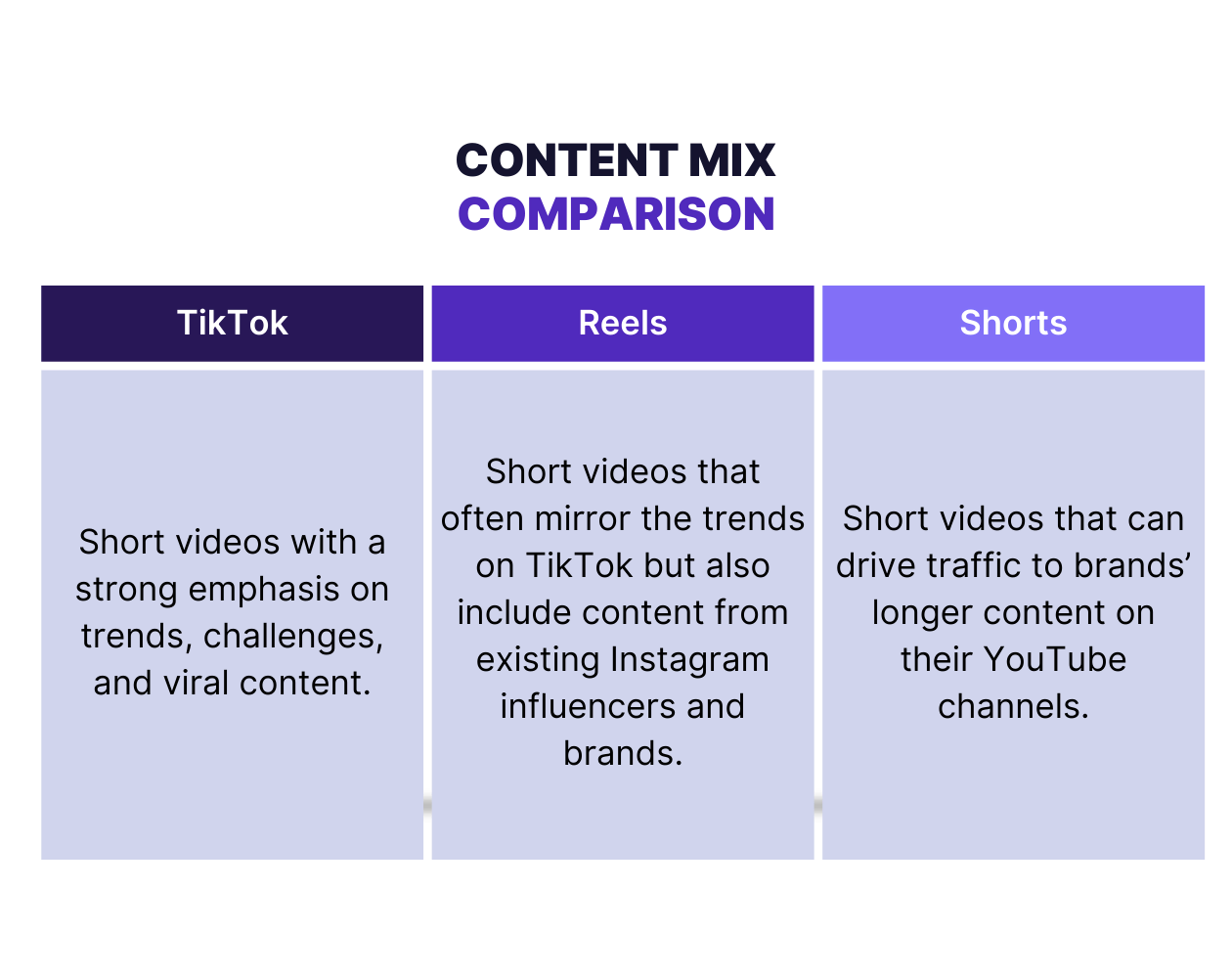
#5. Create engaging, on-brand content
Your social media feeds should be filled with content that looks like it came from a cohesive strategy. An Instagram filled with a mixture of random memes, different colored graphics, and a handful of high-quality product images probably won’t look very cohesive.
Instead, consider the types of content your brand wants to create. Do you want to offer tutorials for how to get the most out of your product? Do you want to create fun memes for your audience to engage with?
More than that, what types of content make sense for your brand to share? For example, fast casual restaurant Chipotle fills its Instagram feed with memes and funny videos.
B2B software company Typeform focuses on branded graphics that incorporate its brand colors and also help inform users about its product and industry.
Put together a list of the types of content that would make sense for your brand to create and share. Then, make sure it’s on brand by:
- Using your brand voice
- Aligning with your branding guidelines
- Incorporating your brand fonts and colors
- Keeping your target audience in mind
#6. Develop social media employer branding programs
Beyond just creating content that entices your target customer, you should also be putting some tactics for enticing potential employees in your social media branding strategy.
Consider this: How do you want your company to appear to job candidates? What kind of company culture do you want to show off? A social media employer branding program is the perfect way to put that kind of information in front of someone who may be interested in applying for a job in the future.
Some ways to implement this include:
- Showcasing your team in your social media content
- Highlighting your company culture
- Promoting and standing behind your mission and values
- Being transparent about the perks and benefits you offer
Here’s a great example of this from Grammarly, as they showcase their newest cohort of interns in a LinkedIn post:

#7. Involve your C-level suite in talking about your brand on social media
One of the biggest challenges that companies face in their social media endeavors is pushback from the C-suite due to misgivings or misunderstandings about what social media can do for a brand.

A general lack of understanding within upper management about the tasks and value of social media teams can lead to undervaluation and underinvestment in social media efforts. - Kassandra Quinn, Social Media Strategist at ModSquad
To combat this, aim to get your company’s C-suite involved. When they see things like:
- The work put into a successful social media post
- The number of social media posts a single video or photo session can create
- The results said work can provide
They’re more likely to grasp why it’s so important to invest in social media and ensure the social media team has an appropriate budget to work with.
Start by interviewing members of the C-suite to gather video content to share on social media. Not only does it make them more human for customers to see their faces, but it also helps your company feel more tangible and relatable.
In addition, get your C-suite members active on social media platforms like LinkedIn, sharing company updates and participating in marketing endeavors.
Here’s a great example from graphic design software Visme, where the CEO is promoting a webinar that he himself is participating in.

#8. Position yourself as a brand authority in your niche
Use social media and your other content offerings to position your brand as an authority within your niche. This helps build trust and credibility when people see your brand online.
There are several ways to do this. First, consider conducting original research that other companies can use as a direct source for their data and statistics. At Socialinsider, we release an annual Social Media Benchmarks report and leverage top platforms like LinkedIn to establish expertise in social media data
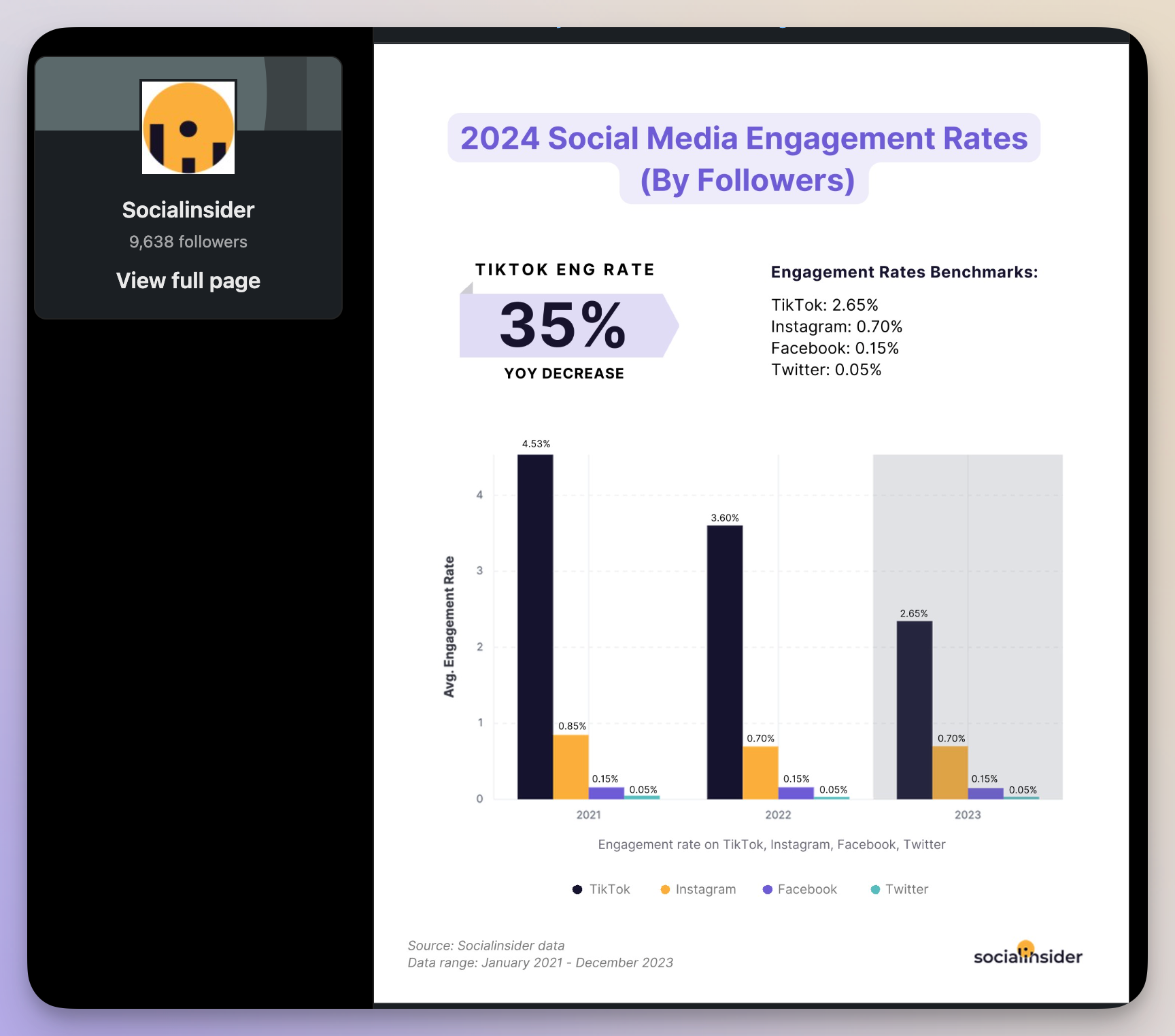
Sharing thought leadership content and valuable tips and tricks of the trade is another way to cement your position as an authority voice within your niche.
Content marketing agency Optimist regularly hosts different voices in the industry for actionable webinars, helping create a name for themselves in the process:

Be sure to add authoritative content ideas like these to your posting strategy. Ensure that any graphics you post in conjunction with this content match your brand so that anyone re-sharing them is further spreading your branding to new audiences.
One great way to gather some of these ideas is through a competitor analysis. What types of content are your competitors sharing that are getting people talking? How can you better emulate some of that original thought content and get your own audience interacting with it?
Take advantage of Socialinsider’s tools to keep an eye on your competitors and some of their top posts. For example, a project management tool might create a project using some of the following competitors to keep an eye on for content ideas.
You can then go check out the Posts dashboard and get a bird’s eye view of their most popular content to help inform your own strategy.
#9. Promote your brand impact on social media
As a part of your social media branding journey, you need to remember that creating a strong brand is not a one-and-done project. It requires continuous promotion and awareness building.
So promote your brand impact by creating a branding campaign on social media. Typically, the basis of a brand campaign consists of promoting your business and its visual identity in the hopes of reaching your target audience, instilling some brand recognition, and increasing the number of followers you have on social media.
While this can include organic posts, it’s typically an advertising campaign designed just to show off your brand. This works extremely well as a retargeting campaign as well.
Here’s an example of what this might look like from Typeform.

A simple image including the company’s brand name, fonts, and other visual elements—plus a high-quality image showcasing what the brand sells.
To run your own branding campaigns, choose the brand awareness objective as you set up your ads. Then, be sure to install your branding elements within the ad—include your logo, add your fonts and colors to the graphic, and better yet, include a high-quality photo of your product(s).
#10. Identify and engage with influencers or other brand partnerships
Partnering with influencers and other brands is another great way to solidify brand recognition and impact with your target audience. The challenge is always identifying the right influencers and brands to work with.
When partnering with influencers, you want to find users that have an audience similar to yours. This is so that—ideally—the influencer’s audience will become interested in what you have to offer, following your account and eventually becoming customers themselves.
As for brand partnerships, it’s important to find a company that complements your own without there being any kind of competition.
We see the perfect example of that below with email marketing platform Flodesk partnering with lead generation/form tool BDOW! to offer a mutually beneficial integration on their website

Part of finding the right influencer and brand partners is making sure they have enough followers and engagement to ensure the partnership would benefit your brand.
Socialinsider can help you compare influencer and brand accounts to compile a list of the best options for each platform you’re looking to partner on.
You can also browse their recent posts to make sure their brand personality and voice aligns with your own, creating a partnership that just makes sense for the both of you.
#11. Team up with your customer service to have a unified customer experience on social media
A lesser-known part of a complete social media strategy includes customer service as well. This can manifest in many different ways. Some brands choose to have customer service reps assist with responding to social media messages, while others create specific channels for customer support on social media.
For example, the calendar app Calendly has an X/Twitter account specifically for customer support.
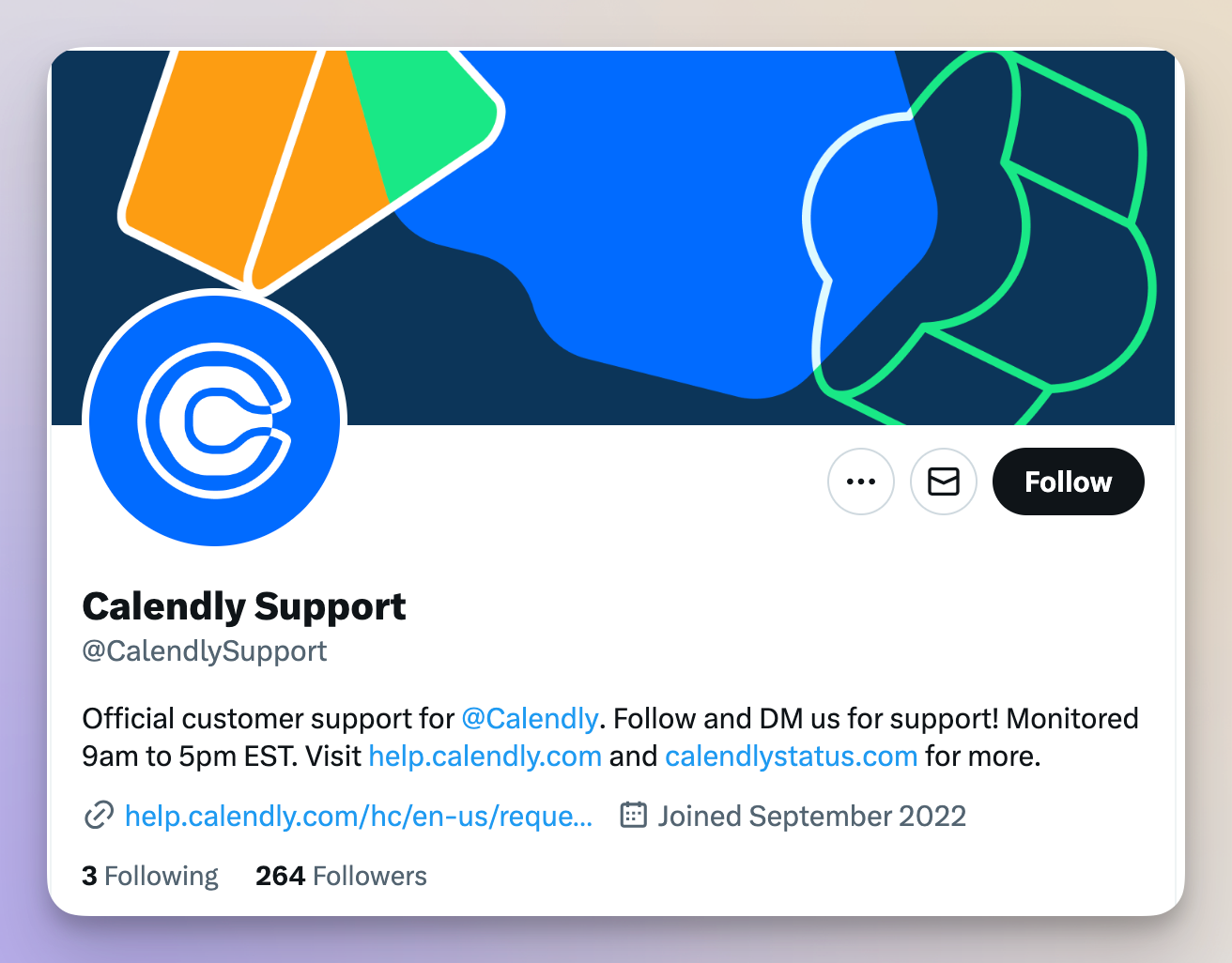
Calendly customers who need help can quickly run to this X/Twitter account to send a direct message with their questions or concerns and get help.
However, Trello does this a bit differently. Instead of offering support directly on their social media platforms, the brand directs people to its customer support page on its website.
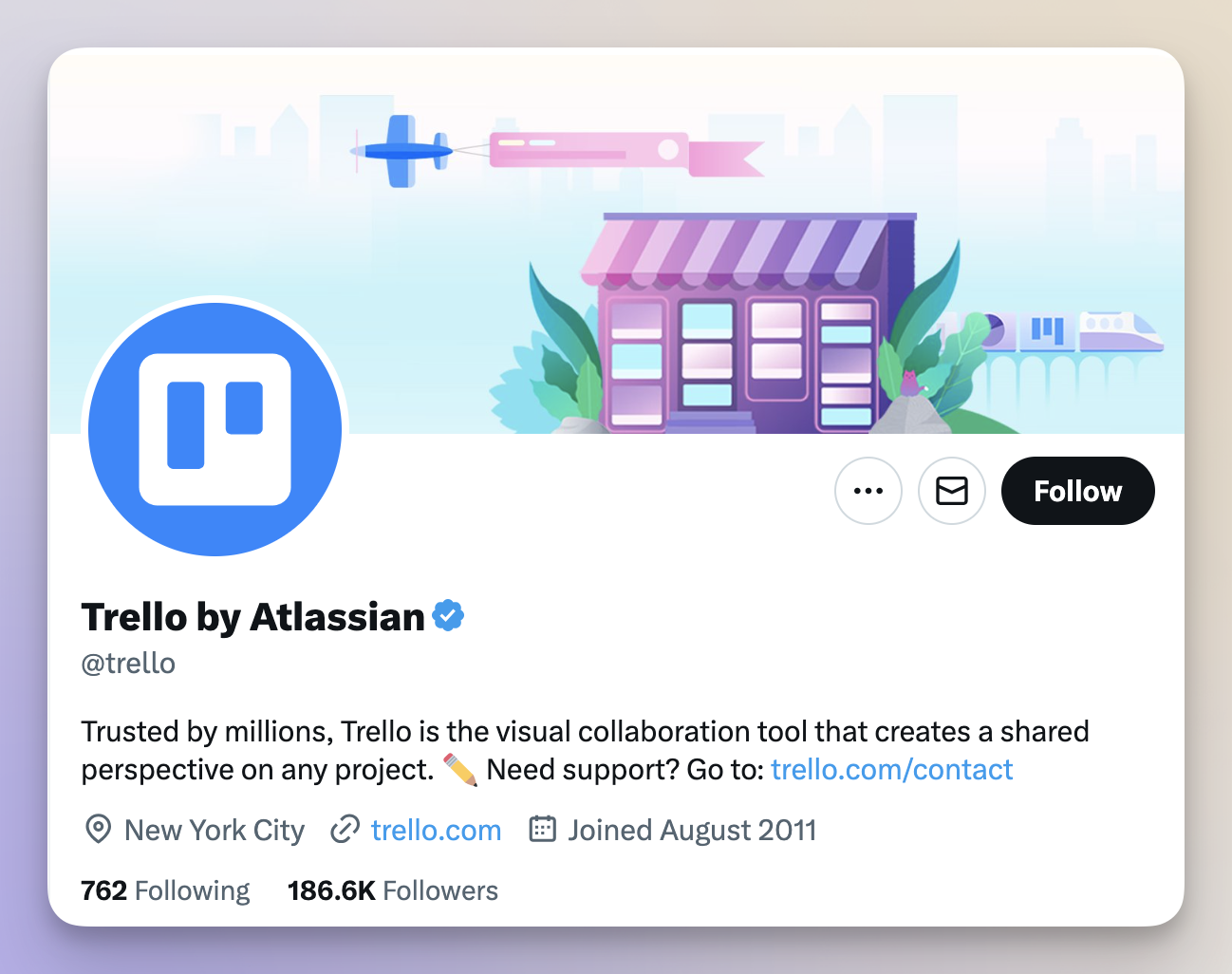
Work with your customer support team to decide what the best option is for your team. But keep in mind that high-quality customer service can have a big impact on the impression people have of your brand.
#12. Analyze your brand performance on social media
Finally, the last part of a good social media branding strategy for your business is to keep an eye on your brand’s performance through your social media analytics. How much reach and recognition are you getting? Are people engaging and resonating with your brand? Is your social media presence growing?
You can find out all of this by performing a cross-channel analysis with Socialinsider to get a glance at all of your posts, social media interactions, follower growth, impressions, and so much more.
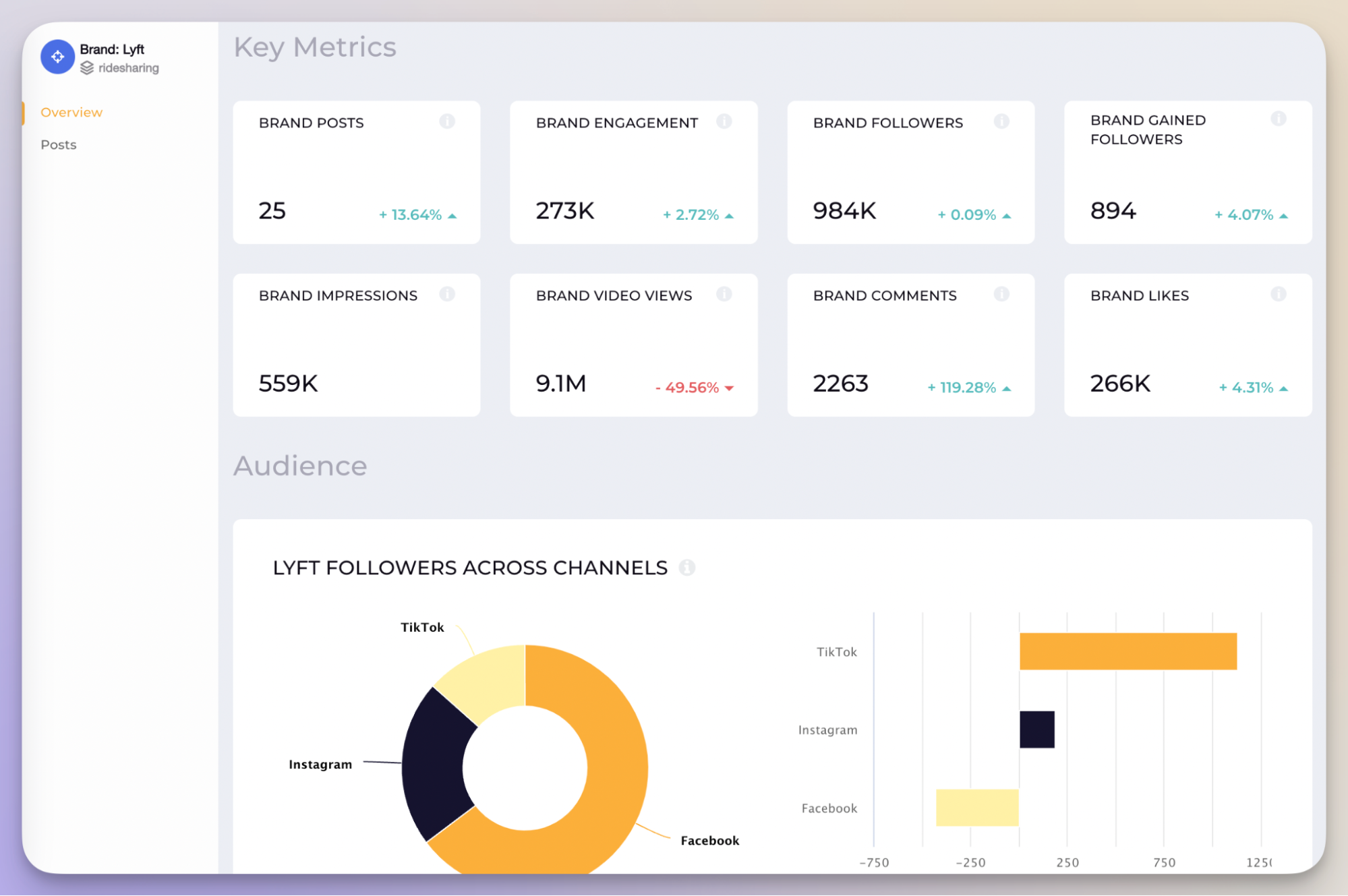
To access the above dashboard, start by creating a brand. Name your brand, then assign a social media profile to it. You can even color code the different brands you add to keep everything organized.
Then, click on that new brand from the left hand sidebar to get an overview of your social media insights—key metrics, audience, posts, engagement, and more.You can also compare your brand performance with your top competitors. Head to the Benchmarks section, then choose the brands you want to compare your brand to in order to view a dashboard like the one below.

Make sure that you’re seeing a steady increase in your own results, otherwise you may need to revisit your social media strategy and overall branding efforts.
Final thoughts
In the past, branding was focused on print media. But in this day and age, it’s even more important to incorporate your branding on your social media posts—via your fonts, colors, voice, personality, and more.
This is why we’ve put together this complete guide on social media branding—to ensure that the impact of your branding efforts makes the right splash, helping you grow your online presence and resonate with your target audience.
Socialinsider can help you make sure you’re on the right track. Take advantage of the analytical tools available to you to create competitor analyses, track your brand performance, and find your voice on social media.
FAQs about social media branding
What is the difference between social media branding and marketing?
Social media branding involves highlighting your company’s defining characteristics—your core values, mission statement, company culture, personality, and generally the very identity of your business.
Social media marketing involves the tactics necessary to put these characteristics in front of your target audience—be it through advertising campaigns, organic posts, influencer marketing, etc.
What is the purpose of social media branding?
In short, a social media branding strategy aims to connect businesses with their audiences on a more personal level.
This allows companies to boost credibility, increase their brand awareness and reputation, as well as build strong active communities, and foster loyal consumer bases.
How to create a social media branding strategy?
Having a thorough understanding of your audience is a key factor in a successful social media branding strategy.
Make sure you understand your followers' pain points, needs, and preferences, and use that information to develop content that resonates with them. Also, prioritize engagement—interact with your audience through comments and spark open-ended conversations within your posts.








